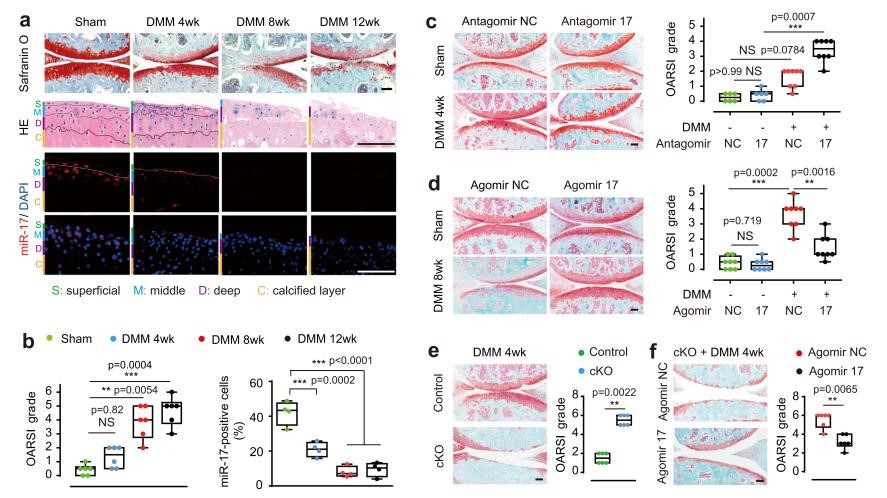A research paper entitled "Dual functions of microRNA-17 in maintaining cartilage homeostasis and protection against osteoarthritis" was published jointly online in Nature Communications recently by research teams from Oriental Hospital and Tongji Hospital, both affiliated to Tongji University. A new pathogenesis of osteoarthritis, MicroRNA-17 (miR-17) is found to play a dual role in maintaining the physiological renewal of articular cartilage and inhibiting the destruction of osteoarthritis cartilage through inhibiting hypoxia inducible factor HIF-1 α and matrix degrading enzymes. In this way, miR-17 is proved to be an important target for the diagnosis, prevention and treatment of osteoarthritis.
Osteoarthritis is among the most common degenerative diseases of synovial joints, which leads to high disability rate and affects the quality of life of the elderly. Osteoarthritis cartilage destruction involves the abnormal activation of inflammatory factors and matrix degrading enzymes. At present, no drug can target multiple factors at the same time to lessen the progressive destruction of articular cartilage. Moreover, how to promote the repair and regeneration of cartilage presents much difficulty to treatment. MMP13 and ADAMTS5 are the two most important enzymes leading to cartilage degradation. The researchers used bioinformatics software to predict the action target of microRNA-mRNA and selected microRNAs that can inhibit MMP13 and ADAMTS5 at the same time. Among them, miR-17 and miR-20a belong to miR-17 ~ 92 gene cluster (six kinds of microRNAs is produced). Cartilage morphogenetic protein GDF-5 may induce the significant up-regulation of miR-17 expression. Previous studies confirmed the essential role of miR-17 ~ 92 gene clusters (especially miR-17) in human and mouse bone development, but their effects on articular cartilage homeostasis and the occurrence and development of osteoarthritis in adulthood were not explored further.
The research results showed that miR-17 was rich in surface and middle chondrocytes and decreased in early osteoarthritis chondrocytes. The down-regulation of miR-17 expression in human osteoarthritis cartilage was related to cartilage destruction. Chondrocyte specific miR-17~ 92 deficient mice or mice injected with miR-17 antagonist had more serious and extensive articular cartilage destruction in the knee osteoarthritis model. Intra articular injection of exogenous miR-17 or the up-regulation of endogenous miR-17 induced by GDF-5 could effectively reduce the severity of osteoarthritis and prevented the destruction of articular cartilage. The effect of miR-17 in the treatment of osteoarthritis was better than other microRNAs in the same gene cluster (Fig. 1). According to the research, miR-17 binding to the specific site of pathological decomposition gene 3 '- UTR could inhibit the expression of MMP3, MMP13, ADAMTS5 and NOS2, and had a multi-target effect. Therefore, miR-17 had a strong and extensive inhibitory effect on cartilage destruction. At the same time, it clarified the mechanism of GDF-5, a key gene of osteoarthritis, inhibiting cartilage catabolism through miR-17 (Fig. 2).

Figure 1. MiR-17 deletion leads to accelerated progression of osteoarthritis
The research teams found that the articular cartilage of miR-17 ~ 92 knockout mice developed lesions without external damage, the number of surface chondrocytes decreased, and the cartilage matrix was edema and loose, but it was not accompanied by the up-regulation of pathological decomposition genes. In order to clarify the mechanism of cartilage spontaneous degeneration, the researchers found out with help of single-cell RNA sequencing technology that the surface cartilage contained two kinds of cells, one of which secreted physiological decomposition enzymes (MMP2 and MMP14) to maintain cartilage tissue renewal; while the other secreted lubricant and presented the characteristics of inner synovial cells, suggesting the developmental homology with synovial tissue. The expression of synthetic phenotype and physiological decomposition factors of knockout miR-17 ~ 92 chondrocytes were significantly down regulated. After intra-articular injection of miR-17, the steady-state level of synthetic and decomposition factors could be restored and the normal structure of cartilage tissue could be maintained, which further proved the essential role of miR-17. In-depth analysis of the sequencing data demonstrated that the expression of several collagen modifying enzymes was increased in miR-17 ~ 92 knockout chondrocytes, and these enzymes were affected by HIF-1 α Protein regulation. The researchers confirmed HIF-1 in articular cartilage α of miR-17 ~ 92 knockout mice and the expression of miR-17 was significantly enhanced. A series of experiments showed that miR-17 was HIF-1α in chondrocytes MiR-17 directly targets and limits HIF-1 α to maintain the normal metabolic level of cells and the physiological homeostasis of cartilage tissue (Fig. 2). The invention patent related to this research (a microRNA for inhibiting osteoarthritis and its application) was authorized in 2019.

Fig. 2. miR-17 inhibiting cartilage destruction and maintaining cartilage homeostasis in osteoarthritis
Professor CUI Lei from Tongji Hospital and Professor SUN Yi from the Oriental Hospital are the corresponding authors of the paper. ZHANG Yun, assistant researcher of the Oriental Hospital, is the first author of the paper. Professor YIN Feng, director of the Department of joint and bone diseases of the Oriental Hospital, provided important guidance for this research. The research was supported by the Key R & D Program of the Ministry of Science and Technology and the National Natural Science Foundation of China.
Link to paper:https://doi.org/10.1038/s41467-022-30119-8
